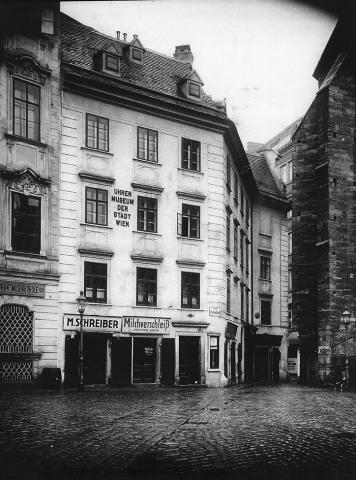The foundation for the future Uhrenmuseum (clock museum) was the private collection of the teacher, Esperantist and timepiece collector Rudolf Kaftan. He originally deposited around 10,000 timepieces and clockwork mechanisms in the Görgen-Sanatorium von Heinrich Obersteiner at Billrothstraße 69 in Vienna's 19th district. When the site was sold in 1917 and the building was to be demolished, the city of Vienna purchased the collection and founded the Uhrenmuseum, which opened on 29 May 1921, after incorporation in the Städtische Sammlungen, in the former Obizzipalais at Schulhof 2 in the 1st district. Kaftan himself was appointed director of the museum and given a service apartment and annual salary. To obtain funds to enlarge the collection, Kaftan founded the Verein der Freunde des Wiener Uhrenmuseums in August 1917. The new museum made extensive acquisitions in 1917 and 1918, while the First World War was still being fought, including the collection of the writer Marie von Ebner-Eschenbach and items from the estates of the Jewish industrialist Gustav Leiner and the renowned Viennese watchmaker and collector Josef Nicolaus. After the war the museum was able to further enlarge its holdings with the financial support of the Social Democratic city government. Thanks to Kaftan's activities, it was highly publicized in the media during this time. Newspapers across the entire political spectrum reported on it, and the museum also attracted many foreign visitors. It remained popular under the Austrofascists after 1934 and enjoyed financial support from the new mayor Richard Schmidt as well as media prominence.
After the annexation of Austria to the Nazi German Reich, the museum was incorporated in the new Group VIII – Department of Culture as an independent entity and in 1939 annexed once again to the Städtische Sammlungen. Rudolf Kaftan was familiar with the collections and stocks of watchmakers and dealers. The Oberaufsicht der kommissarischen Verwalter (office of the temporary administrators), guild and future "Arisierungsstelle" der Zunft der Uhrmacher und Juweliere and Gilde des Uhren- und Juwelenhandels (Aryanization Office for the Watch and Clockmakers and Jewellers Guild and the Guild of the Clock and Jewellery Trade) at Schulhof 6 were close to his apartment, so that he was easily able to obtain information and make acquisitions. On 22 March 1938, for example, Kaftan inspected the collection of 135 timepieces belonging to the Jewish ironmonger and metal goods dealer Paul Schwarzstein. On conclusion of sales negotiations, they were acquired in May 1939 by the Uhrenmuseum. The stocks and collection of the Jewish watchmaker and antiques dealer Alexander Grosz were offered by Josef Berger, temporary administrator of the company, to the museum for purchase, and the museum ultimately purchased seventy timepieces. Others came from the Aryanized stocks of the jeweller and antiques dealers Emil Politzer and Josef Ungar and from the seized art collection belonging to Albert Pollak. The Uhrenmuseum was the subject of numerous articles in the Nazi media. Apart from articles about the 45,000th visitor on 13 May 1938, or the Erste großdeutsche Versammlung der Uhrmacher in Wien (First Greater German Meeting of Watchmakers in Vienna) in July 1939, the media also reported on the many new acquisitions, failing to mention, however, that they often came from expropriated assets. In 1942, Karl Wagner, director of the Städtische Sammlungen, attempted to obtain items formerly owned by the Rothschilds, including twenty-five timepieces acquired by the Uhrenmuseum. Because of the increasing danger of air raids, preparations began in June 1943 for storage of the museum inventory. In January 1944 the Uhrenmuseum was closed and most of its inventory stored in Lower Austria. A large amount of theft by Wehrmacht soldiers, the local population and Soviet troops took place towards the end of the war at the depots Schloss Thalheim and Pfarrhof in Klein-Engersdorf. Thirty items from the Grosz collection and seventy-eight from the Schwarzstein collection disappeared in this way.
In 1948 Clarisse Rothschild "donated" six timepieces to the Uhrenmuseum from the Rothschild collections kept by the Federal Monuments Office, which had been demanded by the museum as compensation for the issuance of export authorization for the other objects restituted in1949. They were not restituted until the adoption of the Art Restitution Act in 1998. In 2001 the Uhrenmuseum returned the surviving sixteen of an original twenty-two timepieces owned by Oscar Bondy. In 2003 the widow of Josef Ungar obtained her husband's timepieces, and in 2004 the heirs of Emil Politzer obtained twenty of the original twenty-five timepieces. Paul Schwarzstein's family managed with the aid of a lawyer in 1949 to have fifty-two timepieces returned, but the museum kept five as a "gift". Based on the systematic provenance research in the Wien Museum, these five timepieces were returned in 2009 on the recommendation of the Vienna Restitution Commission to the legal successors of the Schwarzstein family. Timepieces belonging to Alexander Grosz were restituted in 2017 after a long search for heirs.

